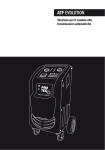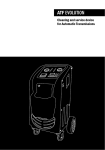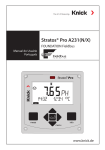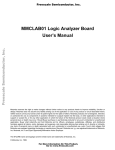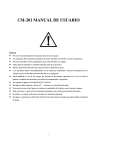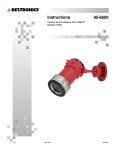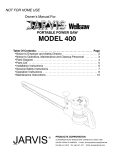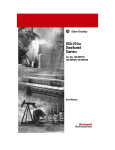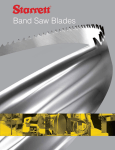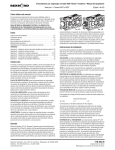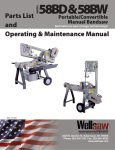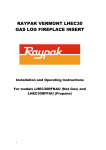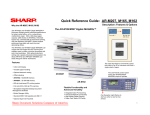Download Wells M327 Specifications
Transcript
M A D E I N U . S . A . Parts List, Operating & Maintenance Manual for Wells No. 5 Metal Cutting Bandsaws M A D E I N U. S. A. 2829 N. Burdick St. • Kalamazoo, MI • 49004 • Phone: (269)345-1132 • Fax: (269)345-0095 • Web: www.wellsaw.com Index Specifications No. 5 .................................................. 2 Safety Instructions .................................................... 3 Installation, Operation & Maintenance...................... 6 Trouble Shooting ...................................................... 7 Replacement Parts .................................................. 8 Replacement Parts for Later Models ...................... 13 Replacement Parts - Blade Tensioning Device ...... 13 For Your Convenience When contacting your WELLSAW supplier or the Company for parts or service, it is helpful to have both your saw Serial Number and Purchase Date available. Jot them down her for handy reference. Serial Number: Wellsaw® Select-O-Chart..................................... 14 Purchase Date: Specifications Standard Capacity: Rectangular ....................................................... 5” x 10” Rounds ................................................................. 5" dia. Speeds: Three Speed Saw –FPM ..............................60, 90, 130 Four Speed Saw - FPM.........................50, 90, 160, 250 Motor Size: ...........................................................................................1/3 HP Swivel Vise: ........................................................................................... to 45° Blade Size: .......................................................................... 8'3" x 1/2" x .025" Height to top of bed: ........................................................................... 25-1/2" Width of Bed .......................................................................................... 8-1/2” Drive: ................................................................................................... “V" Belt Floor Space required: ...................................................................... 21" x 50" Shipping Weight, (approx). ................................................................ 365 lbs. With Coolant....................................................... 420 lbs. Blades are available for No. 5 Wells saw in a variety of tpi 2 SAFETY INSTRUCTIONS Know your machine, its safe and proper use! DISCONNECT POWER before adjusting or servicing the saw or changing a blade. FOR ALL TOOLS STAY CLEAR of all moving parts. Keep hands and fingers away form the saw blade. KEEP GUARD IN PLACE and in working order. WHEN MOVING SAW, with hinged frame (saw head), secure the head in its down position. REMOVE ADJUSTING KEYS AND WRENCHES. Form a habit. Check to see that all keys and wrenches are removed from the tool before turning the tool on. WHEN CUTTING MAGNESIUM, take special precautions. Use a sharp saw blade, make only dry cuts, prevent chip accumulation, and keep fire-fighting equipment nearby. KEEP WORK AREA CLEAN. Cluttered areas and benched invite accidents. THIS SAW SHOULD BE GROUNDED WHILE IN USE TO PROTECT THE OPERATOR FROM ELECTRICAL SHOCK. AVOID DANGEROUS ENVIRONMENT. Do not use power tools in damp or wet locations. Keep your work area well lighted. CORD CONNECTED TOOLS. If the saw is equipped with an approved 3-conductor cord and a 3-prong grounding type plug, it should only be connected to a properly equipped and grounded receptacle. The green conductor in the cord is the grounding wire. Never connect the green wire to a live terminal. KEEP CHILDREN AWAY. All visitors should be kept a safe distance from work area. MAKE WORKSHOP KID-PROOF with padlocks, master switches, or by removing starter keys form tools. DON’T FORCE TOOL. It will do the job better and safer at the rate for which it is designed Use only a 3-wire extension cord having a 3-pronged receptacle, a 3-pronged plug and ample amperage rating. Replace or repair a damaged or worn cord immediately. USE RIGHT TOOL. Don’t use a tool a or attachment to do a job for which it was not designed. WEAR PROPER APPAREL. No loose clothing or jewelry to get caught in moving parts. Rubber-soled footwear is recommended for best footing. PERMANENTLY CONNECTED TOOLS. The saw should be connected to a grounded, metal-enclosed wiring system or an equipment-grounding conductor should be run with the circuit conductors and connected to the saw’s grounding terminal or lead. USE SAFETY GLASSES. Also use face or dust mask if operation is dusty. To reset the manual starter after a power interruption, return the switch to OFF and press the RESET button before restarting. SECURE WORK. Use clamps or a vise to hold work. Provide adequate support to prevent injury from falling work pieces. 3 INSTALLATION, OPERATION and MAINTENANCE of the No. 5 WELLS METAL CUTTING BANDSAW The No. 5 METAL CUTTING BANDSAW was designed for efficient performance, and with proper care will give you many years of dependable service. Each saw is completely assembled, checked thoroughly and subjected to a test run; no further adjustments should be necessary. This manual has been prepared to assist you in the proper installation, operation and maintenance of your new Wells Metal Cutting Band Saw. If you should desire additional information or assistance, we suggest you contact your dealer’s service representative. Read this manual carefully. It was prepared to help you. INSTALLATION • Upon receipt of machine, uncrate and check all parts. Report to your carrier any damage to machine and file Proof of Loss Claim with same. • • • • Place motor in position on motor pivot post and install V-Belt. Be sure motor specifications correspond with your power line. Place machine so that each leg is carrying its share of the load. AUTOMATIC STOP When the saw blade has completed the cut through the material, the saw frame drops on a trigger to which a rod is attached. This rod passes through the frame of the machine to the switch on the opposite side, and opens the contacts, thereby stopping the saw. It will be necessary to raise saw frame clear of the trigger before machine can he started. Read instructions carefully. OPERATION • • • • screw until the blade is taut. Start motor and tighten blade to proper operating tension. Make certain that the blade teeth point same way blade is running; if not, this can he accomplished turning the blade inside out. Do not apply too much feed at first on new blade. Start cut carefully and the blade will last much longer. Make sure all four legs are in solid contact with the floor. Keep blade guides as close to both Vise Jaws as possible. FIXED VISE JAW The two pins in the fixed vise jaw should be kept in place in order to insure square cuts. When cutting angles, these pins must be removed and the vise jaws turned to desired position and tightened with clamp bolts. These pins enable operators to quickly relocate fixed vise jaw for 90° cutting. For final adjustment, the vise jaw should be squared with the blade. PLACING BLADE ON SAW • • • • The sliding vise jaw should be loosened and pushed against fixed vise jaw and then tightened. Raise frame to extreme height. Remove blade guard on high side of frame. Turn idler band wheel tension screw until the blade will slide on wheels easily. With blade uncoiled, place in roller guides and between brushes, then over band wheels. Grasp blade on frame side and push toward guide bracket beam to hold in position, then turn tension NEW BLADE TENSIONING DEVICE On saws equipped with blade tensioning device, tighten hand wheel tension screw until gauge bar is flush with end of casting. 4 SLIDING VISE JAW MAINTENANCE The sliding vise jaw is equipped with a ratchet and ratchet dog for quick action and with a hand wheel for tightening work in vise. Excessive pressure is not required to hold material securely in the vise. BLADE GUIDES MAXIMUM CAPACITY To obtain maximum vise capacity remove vise jaw pins and move fixed vise jaw toward motor end. Make sure stock in vise will not strike the ratchet arm. DASH POT Machines are equipped with a dash pot (frame check) for the purpose of stabilizing the downward travel of the saw frame, thereby protecting saw blade from damage. The action is hydraulic and controlled by flow of fluid being bypassed through an orifice in the piston on the downward stroke. Only light hydraulic oil should be used in the cylinder. SWITCH A “STOP-START” switch is installed across the line to protect the wiring and brushes of the motor. A thermal coil is provided which breaks the circuit should an overload occur in the line. The operator should allow time for coil to cool before trying to start after the circuit has been broken. Automatic shut-off operates when saw frame contacts the switch trigger, which is attached to the frame rest. BELT Usually the weight of the motor holds the belt tight enough, but in case it does not, the clamp on the swivel post should be tightened. SPEED SELECTION Saws are equipped with step pulleys, which provide a selection of speed ranges: • Use the fast speed to cut thin-wall metal, tubing, thin channels, aluminum, thin brass, or any metal that will not burn the teeth. • Use the medium speeds on general cutting such as cold rolled, machine steels, heavy channels, etc. • Use the slow speed for cutting nickel steels or any metals which require a slow speed on a lathe. • Use beeswax when cutting brass. Brass should always be cut with a blade which has not previously cut other metal. • If teeth wear off unusually fast, use slower speed. Always keep the blade at proper blade tension 5 when cutting. The blade guides are arranged to hold the blade in alignment both vertically and horizontally. Before making any adjustments, always try a new blade to be sure that the old blade was not causing the difficulty. To align the blade horizontally, be sure fixed vise is square with bed, then square blade with vise. If out of alignment, loosen one upper set screw In “Roller Adjuster” (M-92) and tighten opposite set screw, moving blade in desired direction. For the vertical alignment, raise frame until blade just clears bed, then place edge of square on bed with end against blade being careful not to contact tooth set. Use feeler gauge not to exceed .002”, adjusting blade so that feeler gauge will not enter at top or bottom between end of square and blade. If out of alignment, loosen one lower set screw in “Roller Adjuster” (M-92) and tighten opposite set screw, moving blade in desired direction. For this vertical alignment, check blade at both front and rear guides. Adjust the side roller guides (#100406-001) with the eccentric axle until both rollers contact blade. When this adjustment is made, the rollers should be adjusted so that the path of the blade is straight and blade is not forced to curve around the rollers. The back edge of the blade should be even with the top surface of the side rollers. The top roller guide (#100406-001) should be in contact with back of blade at all times. Always keep set screws and thumb screws tight. BLADE BRUSHES Brushes should be cleaned frequently in kerosene and reversed to take advantage of both rows of bristles. For best results, replace worn, filled or sticky brushes with new ones. In bolting brushes to angles, be sure wire bristles are bent in same direction blade travels. LUBRICATION • The correct and adequate lubrication is a very important factor in determining the life and service to be obtained. It is imperative that all dust and dirt should be removed before lubricating. • Keep vise adjusting screw well lubricated with a medium type of grease. • The gears in the gear case are lubricated with a metal penetrating type of grease that will not channel. A small quantity of this lubricant can be added through hole in side of gear case when required. • The electric motor has sealed-type ball bearings and should be oiled at regular intervals according to standard practices, when repacking, a high grade medium type of grease should be used. • Keep internal ring gear and pinion well greased with a good quality fiber type grease (medium grade). For proper inspection and for greasing these gears, it is necessary to remove the drive wheel. • Lubricate the motor pivot post with a few drops of machine oil. If properly lubricated, the weight of the motor will keep the belt tight, and allow easy speed changes. • Wheel ball bearings are lubricated by pressing out the bearings and repacking them with a good quality of ball bearing grease. Keep machine clean and be sure no cuttings are allowed to mix with lubricants, as this forms an abrasive which is detrimental to the operation of the machine. Use only hydraulic oil for dash pot. WHEEL PITCH ADJUSTMENT Loosen Blade Before Making These Adjustments! In case the blade runs too low, or off the idler wheel, adjust the wheel block to which the wheel is mounted. To do this, loosen the two cap screws marked “1” one-half turn and tighten two cap screws marked “2” an equal amount. To make similar adjustment on drive wheel at motor end, it is necessary to loosen the two cap screws at “3”, then make pitch adjustment by loosening two hollow head set screws at “4” and tighten two hollow head set screws at “3”. The four cap screws should then be tightened to hold motor plate in a rigid and fast position. If there is too much pitch on the wheel the blade will run too high. This will cause the blade to become distorted and the back of the blade will be rolled over, also the wheel rim flange will show excessive wear. To correct this condition, loosen two cap screws at “2”, tighten two cap screws at “1”. Loosen two cap screws at “4”, then make pitch adjustment by loosening two hollow headset screws at “3” and tightening two hollow head set screws at “4”. The four cap screws should then be tightened to hold motor plate in a rigid and fast position. FRAME WEIGHT ADJUSTMENT Place weight on slide bar at motor end of slide and remove dash pot, before adjusting frame spring under motor end, The frame spring should be adjusted for approximately 10 Ibs. Use slide weight to make final feed adjustment. The cutting pressure, which determines the feed, should not be increased to a point where the blade starts to run sidewise while cutting. Large stock will stand a heavier feed than small stock. 6 Trouble Shooting For Greater Service and Efficiency Careful Operation - Blade Consideration DIFFICULTY REASON REMEDY Cutting out of line Too heavy a feed or worn blade Guides in wrong position Set as close to work as possible Guides out of alignment Follow adjustment instructions Set worn on one side of blade Keep brushes clean. Avoid teeth rubbing in cut by applying enough weight so that each tooth is cutting a good chip Starting cut on odd shape where blade does not contact flat surface Stripping teeth Breaking Excessive wear Reduce feed rate by adjusting frame weight or replace blade. Replace worn guide bearings when they begin to show excessive wear Retard feed until blade has a good start in the material Blade teeth too coarse Be sure that two or more blade teeth are in contact with material being cut Hard spots on material Rotate stock, if possible. Do not put new blade in cut at same angle Guides out of alignment Follow adjustment instructions. Blade twisting Adjust guides as close to work as possible. Be sure material being cut is held firmly Lack of blade tension Always keep blade tight Dash Pot malfunction Check hydraulic fluid level and/or condition of cup leather Blade speed too fast. Follow recommended cutting speeds Blade running off Lack of blade tension wheel Improper wheel pitch adjustment Always keep blade tight See instructions for wheel pitch adjustment Always use a light feed on new blades! 7 Replacement Parts A11 A14 A16 A17A A17B A19 A22 A31 A42 A86 A94 101172-1 Spring Bed Hand Wheel Band Wheel, Drive (shown as A17) Band Wheel, Idler (not shown) Saw Frame Ratchet Arm Fixed Vise Jaw Motor Plate Internal Ring Gear Motor Pulley (3 speed saw) Motor Pulley (4 speed saw) 8 Replacement Parts A4 A5 A6 A12 A15 A18 A34 A49 A50 A54 A62 A90 A101 A160 A163 A174 Vise Ratchet Dog Vise Ratchet Vise Slide Block with (A45) Vise Slide Block Guide. For assembled unit order both parts *Wheel Slide Block (3 speed saw) Leg Guide Bracket Beam Spring Adjuster Housing Blade Guard Frame Pivot Bar (shown on page 11) Switch Rod used with Bryant No. 3972 (shown on page 12) Stock Stop Bar Roller Guide Bracket Sliding Weight Bar *Belt Guard (3 speed saw) Bracket Thumb Screw (not shown) same as M163 Switch Rod used with CH No. 9115 (not shown) *Refer to page 13 for replacement part number of later model saws. 9 Replacement Parts A3 A9 A10 A13 A23 A25 A26 A27 A28 A35 A36 A38 A40 A46 A81 A103 A104 A108 A113 A132 A151 A2330 A157 Sliding Vise Jaw Wing Screw Block Wheel Adjusting Block Stock Stop Gauge Ratchet Dog Arm Frame Handle Frame Rest Dash Pot Bracket Switch Cover (Bryant) Wheel Axle (not furnished) order M429 Stock Stop, Arm Housing Take Up Screw (complete unit) Vise Ratchet Guide Spool Wheel Slide Block Guide Ratchet Dog *Blade Brush Angle (inside frame) *Blade Brush (inside frame) Short Eccentric Roller Axle *Motor Pivot Post (3 speed saw) Vise Ratchet Dog Hinge Pin Clamp Nut Only *V Belt, same as 2330 Cable, Motor to Switch (see page 12) *Refer to page 13 for replacement part number of later model saws. 10 Replacement Parts M13 M30 A50 M60 M65 M68 M76 M91 M92 M95 M105 M110 M111 M112 M138 M153 M159 3102 3972 8115 8504 Ball Bearing for Pinion Shaft Ball Bearing for Upper End M111 or M171 Pulley Shaft; also for Band Wheels 100406-001 Blade Guide Bearings M216 Spring Gear Case Frame Spring Arm Frame Pivot Bar *Vise Screw with M177 Collar Assembled Unit Fixed Vise Jaw Locking Pin *Drive Pinion Vise Screw Bracket Roller Support Roller Adjuster *Driven Pulley (3 speed saw) Rod Ratchet Lever *Plastic Gear with M165 Hub *Pulley Shaft and Pinion (.625 dia) *Drive Pinion Shaft Cylinder for Dash Pot (inner) Cylinder for Dash Pot (outer) Thumb Screw and Wing Nut for Spring Adjuster Ball Bearing for Lower End M111 Pulley Shaft Switch. Call factory with complete specs The following parts are not shown: M156 M167 M168 M171 M172 M181 M189 M190 3202 11 5/16 x 7/8 Thin Head Cap Screw 5/8 Nut with Set Screw for Frame Pivot Bar Washer for Dash Pot Cup, leather Pulley Shaft and Pinion .590 diameter Spacer for A35 Switch Rod Post (CH No. 9115) *Driven Pulley Key Plastic Gear Key Ball Bearings for Lower End M171 Pulley Shaft Replace Parts M27 M29 M34 M44 M52 M53 M61 M64 M100 M102 M107 M141 M144 M147 M148 M155 A157 Cable, Motor to Switch, No. 5 Saw SK2525 Wheel Ball Bearing (not furnished) Replaced by two ND No. 8504 Bearings and one M172 Spacer M158 Cable, Complete, Motor to Outlet (not furnished) M163 Thumb Screw for Sliding Weight, used with M100 M166 Dash Pot Cup Leather Gear Case Cover Switch Trigger Switch Trigger Axle Short Roller Axle Motor Plate Pivot Pin Motor Plate Pivot Pin Holder Vise Screw Nut 7/8 x 9 LH Lock Nut for Vise Screw Hand Wheel Steel Sliding Weight (not furnished - order No. M807 - cast) Sliding Weight Post Ratchet Rod Lever Collar Dash Pot Piston Rod with M142 Piston, assembled unit Dash Pot Piston Rod End Dash Pot Lower Bolt Dash Pot Spring Dash Pot Upper Stud The following parts are not shown: M54 M188 M198 M425 M426 M807 M857 12 Switch Rod Driven Pulley Spacer Blade Brush Bracket Blade Brush Angle Blade Brush Cast Iron Sliding Weight Sliding Weights Stop Spring Replacement Parts for Later Model No. 5 Wells Metal Cutting Bandsaws A12 Wheel Slide Block used on saws up to and including Serial No. 5M-6841. Later model saws order No. 101171. A103 Blade Brush Angle (inside frame) used on saws prior to Serial No. 2975. Later model saws use M425 Blade Brush Angle. A104 Blade Brush (inside frame) used on saws prior to Serial No. 2975. Later model saws use M-426 Blade Brush. A113 Motor Pivot Post for 3 speed saw. Order 101157 Motor Pivot Post for 4 speed saw. A160 Belt Guard for 3 speed saw. Order 101182 Belt Guard for 4 speed saw. M68 Drive Pinion used on saws up to and including Serial No. 5M-7302 Order a 101643 Drive Pinion Shaft Assembly (includes drive pinion, drive pinion shaft and roll pin). Later model saws use 101645 Drive Pinion drilled for roll pin. M95 Driven Pulley used on 3 speed saws. For 4 speed saws order 101156 Driven Pulley. M110 Plastic Gear with M165 Hub replaced with M327 for all model saws. Pulley Shaft and Pinion (.625 dia.) replaced with one M171 Pulley Shaft & Pinion and one 3202 Ball Bearing for 3 speed saw. Order 101187 Pulley Shaft & Pinion for 4 speed saw. M111 M112 A2330 V Belt used on 3 and 4 speed saws order No. 100066-5. M60 Vise Screw with M177 Collar Assembled Unit replaced with M307 for all model saws. Drive Pinion Shaft used on saws up to and including Serial No. 5M-7302. Order a 101643 Drive Pinion Shaft Assembly (includes drive pinion, drive pinion shaft and roll pin). Later model saws use 101644 Drive Pinion Shaft. M189 Driven Pulley Key for 3 speed saw. Order No. 100056-15 for 4 speed saw. Replacement Parts - Blade Tensioning Device 101402 Tension Gauge Nut Assembly 100004-15 Cap Screw S20 Tension Spring 1000410-1 Bearing 101171 Slide Block 101162 101167 Take Up Support Take Up Screw Assembly 13 Wellsaw® Select-O-Chart To assist in selecting the right blade and the right speed for your job! Speed = Suggested blade speed in feet-per-minute Feeding pressure: L = light, M = medium, H = heavy • T = teeth per inch 14














